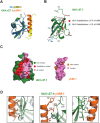Structural and functional characterization of a ubiquitin variant engineered for tight and specific binding to an alpha-helical ubiquitin interacting motif
- PMID: 28276594
- PMCID: PMC5405428
- DOI: 10.1002/pro.3155
Structural and functional characterization of a ubiquitin variant engineered for tight and specific binding to an alpha-helical ubiquitin interacting motif
Abstract
Ubiquitin interacting motifs (UIMs) are short α-helices found in a number of eukaryotic proteins. UIMs interact weakly but specifically with ubiquitin conjugated to other proteins, and in so doing, mediate specific cellular signals. Here we used phage display to generate ubiquitin variants (UbVs) targeting the N-terminal UIM of the yeast Vps27 protein. Selections yielded UbV.v27.1, which recognized the cognate UIM with high specificity relative to other yeast UIMs and bound with an affinity more than two orders of magnitude higher than that of ubiquitin. Structural and mutational studies of the UbV.v27.1-UIM complex revealed the molecular details for the enhanced affinity and specificity of UbV.v27.1, and underscored the importance of changes at the binding interface as well as at positions that do not contact the UIM. Our study highlights the power of the phage display approach for selecting UbVs with unprecedented affinity and high selectivity for particular α-helical UIM domains within proteomes, and it establishes a general approach for the development of inhibitors targeting interactions of this type.
Keywords: phage display; protein engineering; ubiquitin; ubiquitin interacting motif.
© 2017 The Protein Society.
Figures



Similar articles
-
Dimerization of a ubiquitin variant leads to high affinity interactions with a ubiquitin interacting motif.Protein Sci. 2019 May;28(5):848-856. doi: 10.1002/pro.3593. Epub 2019 Mar 12. Protein Sci. 2019. PMID: 30793400 Free PMC article.
-
Conformational dynamics and structural plasticity play critical roles in the ubiquitin recognition of a UIM domain.J Mol Biol. 2010 Mar 5;396(4):1128-44. doi: 10.1016/j.jmb.2009.12.052. Epub 2010 Jan 4. J Mol Biol. 2010. PMID: 20053359 Free PMC article.
-
Solution structure of Vps27 UIM-ubiquitin complex important for endosomal sorting and receptor downregulation.EMBO J. 2003 Sep 15;22(18):4597-606. doi: 10.1093/emboj/cdg471. EMBO J. 2003. PMID: 12970172 Free PMC article.
-
Double-sided ubiquitin binding of Hrs-UIM in endosomal protein sorting.Nat Struct Mol Biol. 2006 Mar;13(3):272-7. doi: 10.1038/nsmb1051. Epub 2006 Feb 5. Nat Struct Mol Biol. 2006. PMID: 16462748
-
Generation and Characterization of Engineered Ubiquitin Variants to Modulate the Ubiquitin Signaling Cascade.Cold Spring Harb Protoc. 2024 Apr 1;2024(4):107784. doi: 10.1101/pdb.over107784. Cold Spring Harb Protoc. 2024. PMID: 36997275 Review.
Cited by
-
Discovery of an exosite on the SOCS2-SH2 domain that enhances SH2 binding to phosphorylated ligands.Nat Commun. 2021 Dec 2;12(1):7032. doi: 10.1038/s41467-021-26983-5. Nat Commun. 2021. PMID: 34857742 Free PMC article.
-
A General Strategy for Discovery of Inhibitors and Activators of RING and U-box E3 Ligases with Ubiquitin Variants.Mol Cell. 2017 Oct 19;68(2):456-470.e10. doi: 10.1016/j.molcel.2017.09.027. Mol Cell. 2017. PMID: 29053960 Free PMC article.
-
Identification and Characterization of Mutations in Ubiquitin Required for Non-covalent Dimer Formation.Structure. 2019 Sep 3;27(9):1452-1459.e4. doi: 10.1016/j.str.2019.06.008. Epub 2019 Jul 11. Structure. 2019. PMID: 31303481 Free PMC article.
-
Structural and functional characterization of ubiquitin variant inhibitors for the JAMM-family deubiquitinases STAMBP and STAMBPL1.J Biol Chem. 2021 Oct;297(4):101107. doi: 10.1016/j.jbc.2021.101107. Epub 2021 Aug 21. J Biol Chem. 2021. PMID: 34425109 Free PMC article.
-
A Structure-Based Strategy for Engineering Selective Ubiquitin Variant Inhibitors of Skp1-Cul1-F-Box Ubiquitin Ligases.Structure. 2018 Sep 4;26(9):1226-1236.e3. doi: 10.1016/j.str.2018.06.004. Epub 2018 Jul 19. Structure. 2018. PMID: 30033217 Free PMC article.
References
-
- Pickart CM (2001) Mechanisms underlying ubiquitination. Annu Rev Biochem 70:503–533. - PubMed
-
- Huang TT, D'Andrea AD (2006) Regulation of DNA repair by ubiquitylation. Nat Rev Mol Cell Biol 7:323–334. - PubMed
-
- Glotzer M, Murray AW, Kirschner MW (1991) Cyclin is degraded by the ubiquitin pathway. Nature 349:132–138. - PubMed
-
- Nakayama KI, Nakayama K (2006) Ubiquitin ligases: cell‐cycle control and cancer. Nat Rev Cancer 6:369–381. - PubMed
MeSH terms
Substances
Grants and funding
LinkOut - more resources
Full Text Sources
Other Literature Sources
Molecular Biology Databases
Research Materials

